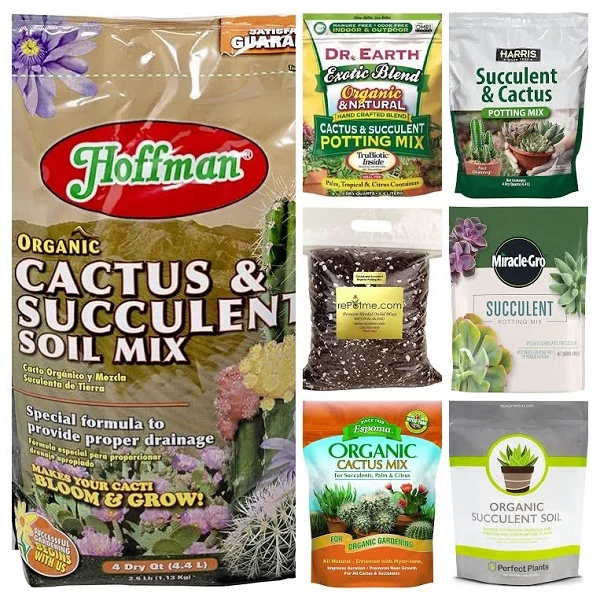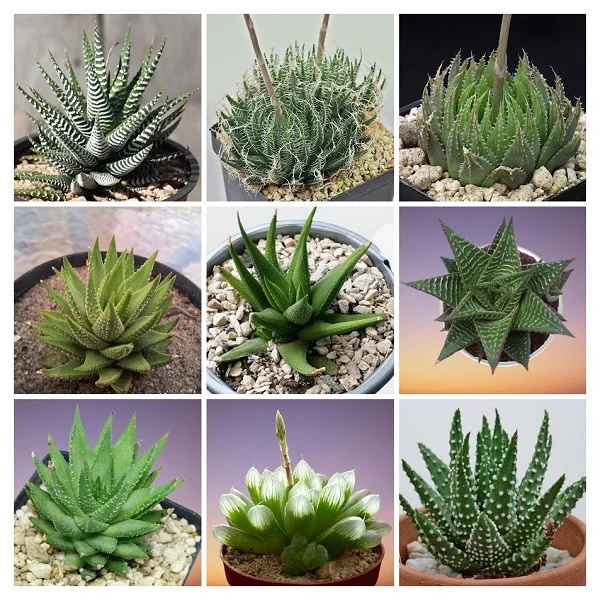15 Types of Aloe Succulent Plants with Names and Pictures
Some links in this post may be affiliate links
Aloe Succulent Plants bear a stemless rosettes of fleshy leaves and tubular, yellow, orange, pink or red flowers which are densely clustered and pendant at the apex of simple or branched leafless stems.
Aloes reproduce by means of offsets (pups) which form at the base of the plant once the plant has reached maturity.
The Aloe genus is native to tropical and southern Africa, Madagascar, Jordan, the Arabian Penisula and various islands in the Indian Ocean.
There are over 600 species in the Aloe genus. The most popular species of Aloe Plants is Aloe barbadensis, the Aloe vera or "true aloe".

Aloe barbadensis is cultivated as the standard source of Aloe vera juice which is used for assorted pharmaceutical purposes. In the home this juice is used for treatment of burns and various skin conditions.
Aloe Plants thrive in bright light with 6-8 hours of direct sunlight, warmth of 16-280C, humidity of 50-55% and moderately moist, rich, well-drained succulents potting soil coupled with monthly feeding in the growing season. Learn how to grow and care for Aloe Succulents.
Aloes are slow-growing plants which require repotting only when pot-bound. Pruning is necessary to keep the plant neat as well as discourage pest and disease infestations.
If you would like to add the elegant Aloe plants to your collection, we have herebelow listed for you 15 popular Aloe Types that are perfect for growing in the home.
15 Aloe Succulent Types for the Home
Popular Aloe Plants are Aloe barbadensis, Aloe aristata, Aloe humilis, Aloe jucunda, Aloe mitriformis, Aloe polyphylla, Aloe ferox, Aloe variegata among others.
1. Aloe barbadensis (Aloe vera)
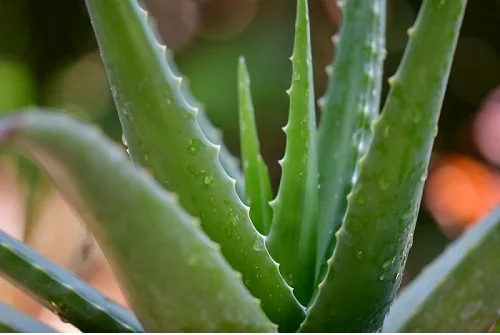
Aloe barbadensis commonly called Aloe vera is one of the most popular of the Aloes and is cultivated as the standard source of Aloe vera juice which is used for assorted pharmaceutical purposes.
The leaves in Aloe Vera are thick and fleshy, green to grey-green, with some varieties showing white flecks on their upper and lower stem surfaces. The leaf margin is serrated and has small white teeth.
Aloe vera is native to the south-east Arabian Peninsula in the Hajar Mountains in north-eastern Oman and eastern U.A.E but it has been naturalized in many regions of the world.
2. Aloe aristata (Lace Aloe)
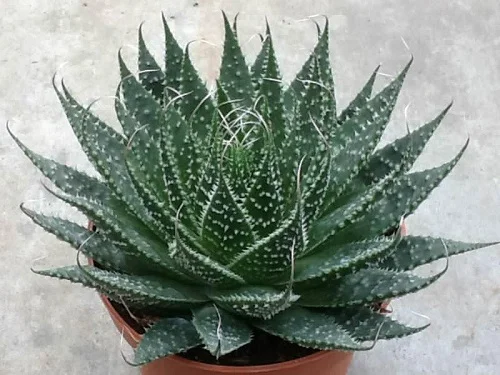
Aloe aristata is another common Aloe for indoors whose 4 in. long leaves form a globular rosette which when mature produces a large number of offsets, the leaves have white warts.
Lace Aloe also called Guinea-fowl Aloe is native to South Africa and Lesotho where it inhabits a range of environments, from dry and sandy to the high grasslands and cold mountain slopes and shady forested valleys.
Aloe aristata is more cold tolerant than other Aloes but it will need to be protected from harsh winter conditions. Like other Aloes it requires well drained soil and sunny to shade conditions.
3. Aloe humilis (Spider Aloe)
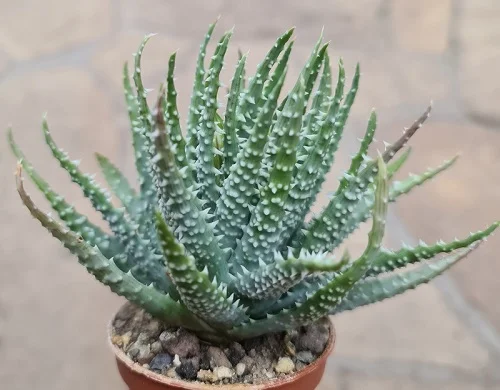
Aloe humilis is a dwarf succulent plant with dense clusters of stemless or very short-stemmed rosettes of blue-green leaves with irregular bumps and bear white teeth along the margins.
Spider Aloe bears triangular, erect or incurved leaves and red to orange, pendulous, tubular flowers which appear from late winter to spring.
The species name, 'humilis' is Latin for 'low-growing or dwarf' in reference to the species' low-growing habit. It is native to Cape Province in South Africa where it grows in dense clumps.
4. Aloe jucunda
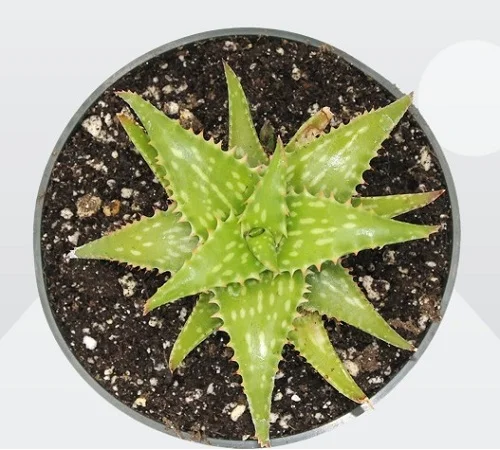
Aloe jucunda is a small species forming 3 inches rosettes of spiny, cream-blotched dark leaves usually about twelve, flecked with pale green spots and triangular teeth on the margins.
Aloe jucunda is indigenous to Northern Somalia where it occurs only in dry forests on limestone at altitudes from 1060 to 1680 meters above sea level.
Due to the continued degradation of its habitat, Aloe jucunda is currently listed as critically endangered by the IUCN ( International Union for Conservation of Nature).
5. Aloe mitriformis (Rubble Aloe)
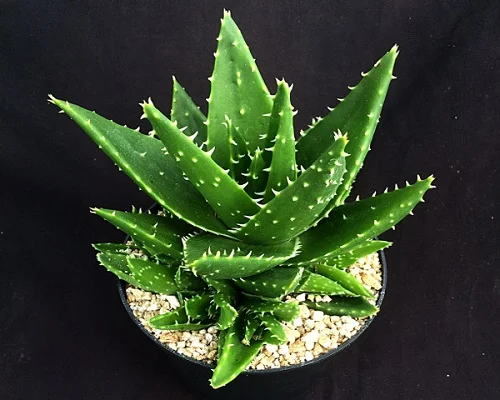
Aloe mitriformis also called Aloe perfoliata is a hardy, thorny, creeping Aloe which is found in rocky, mountainous areas throughout the Western Cape, South Africa.
While most of the branches lie along the ground, the terminal leaf-bearing head is often erect, facing upwards to the sun. The leaf margins are armed with harmless, little white teeth
Rubble Aloe also called Mitre Aloe is extremely variable depending on the growing environment which makes it difficult to identify sometimes.
Whereby plants growing in full sun develop tightly arranged bluish leaves, while those in the shade have more widely spaced green leaves. In dry conditions, the leaves assume a red colour.
6. Aloe polyphylla (Spiral Aloe)
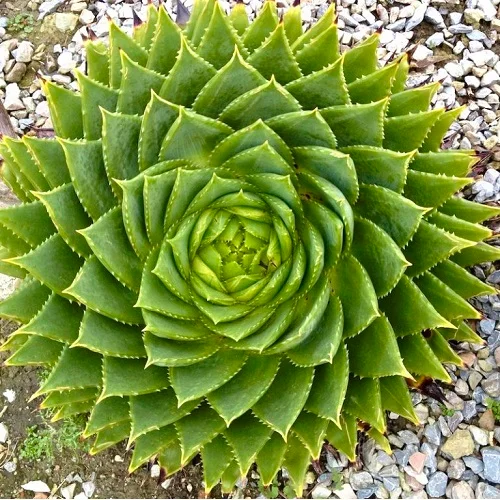
Aloe polyphylla is an evergreen, succulent, perennial plant with strikingly symmetrical, five-pointed spiral growth habit which may be clockwise or anti-clockwise.
The leaves in Spiral Aloe are fat, wide, serrated, gray-green have sharp, dark leaf-tips and it flowers at the beginning of summer, producing flowers that range in colour from red to salmon pink and occasionally yellow.
Spiral Aloe also called Many-leaved Aloes is native to South Africa and grows in high, mountainous, grassy slopes at altitudes between 2,000 and 2,599 metres above sea level or higher on east-facing slopes where it clings to rocky crevices and well-drained scree slopes.
7. Aloe ferox (Bitter Aloe)
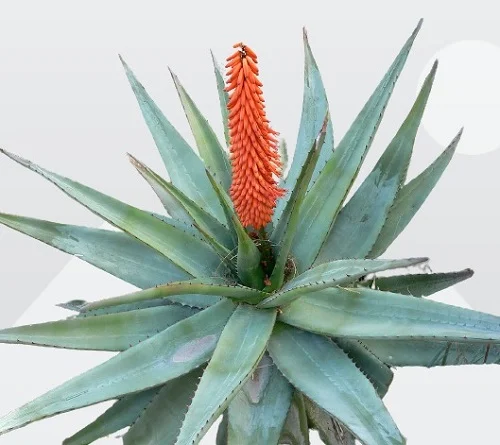
Aloe ferox is a 10 feet tall, single-stemmed Aloe whose leaves are thick and fleshy, arranged in rosettes, and have reddish-brown spines on the margins with smaller spines on the upper and lower surfaces.
The flowers in Bitter Aloe are a uniform orange or red, and stand between 2 and 4 feet above the leaves, in multi-branched inflorescences which bear up to eight very dense, cylindrical, symmetrical, racemes and un-curved, tubular flowers with brown inner segment tips.
Bitter Aloe also called Cape Aloe, Red Aloe and Tap Aloe, native to Southern Africa is used to make bitter aloes, a purgative medication and also yields a non-bitter gel that can be used in cosmetics.
8. Aloe variegata (Tiger Aloe)
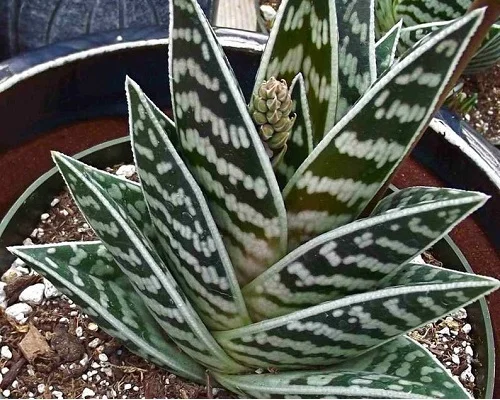
Aloe variegata also called Gonialoe variegata bears succulent leaves with a rich green colour with irregular light green banding made up of amalgamated, slightly raised oval spots, and similarly light coloured fine serrations along each edge.
Tiger Aloe also called Partridge-breasted Aloe reaches maturity in three to seven years, largely dependent on the space, sunlight and water available, at which point they will begin to flower.
The flowers in Partridge-breasted Aloe are orange, arranged in a raceme, develop in a cluster at the head of the raceme and are spaced out by its rapid elongation.
9. Aloe distans (Jewel Aloe)
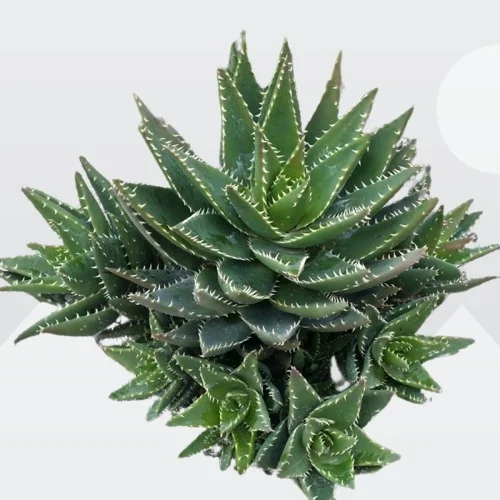
Aloe distans is a compact, stemless, succulent with broadly, waxy, triangular-shaped leaves which are pale blue-green in shade and develop tinges of pink and purple in bright light.
The leaves in Jewel Aloe are covered in white, soft, teeth along the edges and back of the leaves. The flower spikes are bright yellow to scarlet tubular flowers which appear in spring.
Aloe distans also called Aloe perfoliata var. distans is native to South Africa where it grows in rocky ridges and slopes in clay in stony ground.
10. Aloe striata (Coral Aloe)
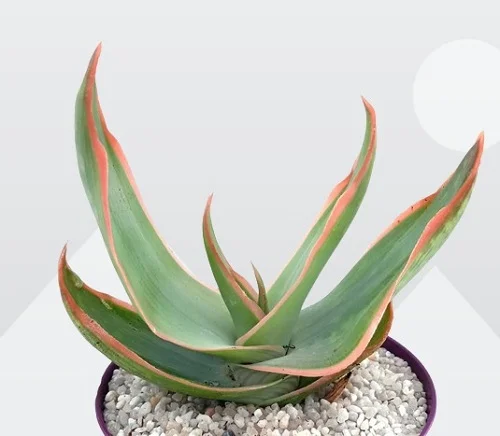
Aloe striata is a small, stemless, succulent plant which bears blue-green leaves with long lines (sometimes very faint) but are not toothed and have a smooth pink margin.
Coral Aloe occurs quite widely over the southern parts of the Cape Floristic Region, in the Eastern Cape Province and Western Cape Province of South Africa where it is found on rocky slopes in coastal and karoo areas.
Aloe striata is a hardy Aloe which bears coral red blooms that attract hummingbirds and insects.
11. Aloe arborescens (Candelabra Aloe)
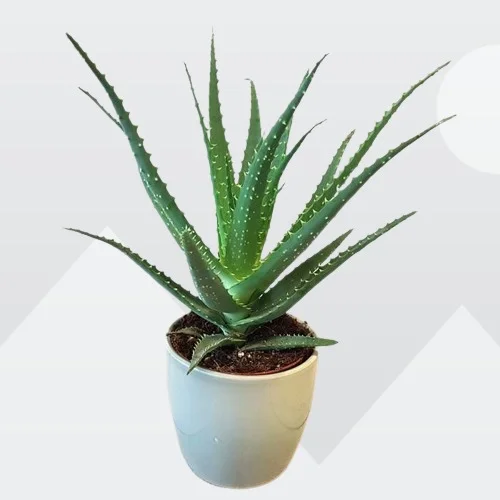
Aloe arborescens is a large, multi-headed, sprawling succulent, tree-like Aloe which bears green leaves with a slight blue tint and have small spikes along its edges.
The flowers in Candelabra Aloe also called Krantz Aloe are cylindrical in shape and are a vibrant red-orange color arranged on an unbranched a raceme.
Aloe arborescens is native to the south eastern part of Southern Africa where it is found growing in mountainous areas, including rocky outcrops and exposed ridges.
12. Aloe maculata (Soap Aloe)
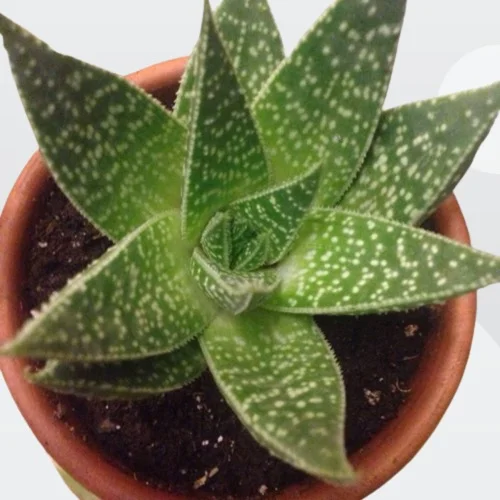
Aloe maculata also called Aloe saponaria bears leaves which range in colour from red to green, but always have distinctive 'H-shaped' spots and the flowers range from bright red to yellow, but are always bunched in a flat-topped raceme.
The name, 'saponaria' is Latin 'sapo' for soap, as the sap makes a soapy lather in water while 'maculata' means speckled or marked in reference to the leaf spots.
Soap Aloe is native to Southern Africa where the plant gel is used traditionally as a remedy for skin complains, inflammation, respiratory system, muscular-skeletal system, poisoning, circulation and endocrine system diseases.
13. Aloe bakeri

Aloe bakeri an evergreen perennial which forms multiple rosettes of spidery succulent green or reddish-green toothed leaves, heavily mottled with white and and bear straight or slightly curved white teeth.
It produces red or orange, green-tipped tubular flowers in summer which are attractive to birds, bees, and wasps and are borne on racemes 12 inches tall.
The Latin species name, 'bakeri' is in honour of the British horticulturalist, John Gilbert Baker of Kew (1834-1920).Aloe bakeri has gained the Royal Horticultural Society's Award of Garden Merit.
14. Aloe brevifolia (Short-leaved Aloe)
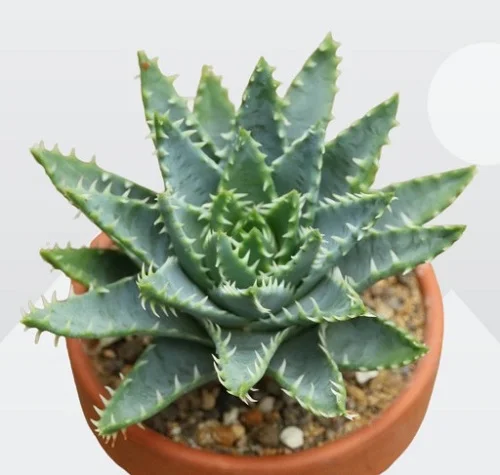
Aloe brevifolia is a tiny, compact, blue-green evergreen succulent perennial with short, fat, gray-blue leaves which are edged with soft, harmless, white teeth and bright red flowers.
The species name 'brevifolia' is Latin for 'short-leaf' in reference to the short leaves. The plant tends to sprout suckers from its sides that become new rosettes and consequently forming large clumps.
Short-leaved Aloe is native to the Western Cape, South Africa in the dry clay soil of “Rûens Shale Renosterveld” and is listed as Vulnerable on IUCN's global Red List due to the destruction of its natural habitat.
15. Aloe broomii (Snake Aloe)

Aloe broomii is a single-stemmed Aloe with fleshy succulent leaves edged with very dark, small thorns and the flowers are hidden by the extended bracts, giving it a sinuous, snake-like appearance.
Snake Aloe also called Mountain Aloe is widespread in South Africa and Lesotho where it grows on rocky slopes in hilly and mountainous areas, at an altitude of between 1000 and 2000 metres above sea level.
Aloe broomii attracts a wide variety of pollinators like bees, wasps, ants and sunbirds and is used as an disinfectant, an ear remedy for sheep, and a pesticide to purge ticks from livestock.

